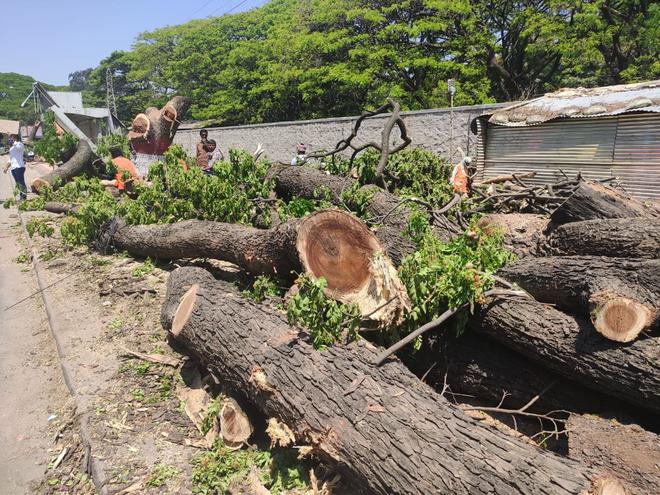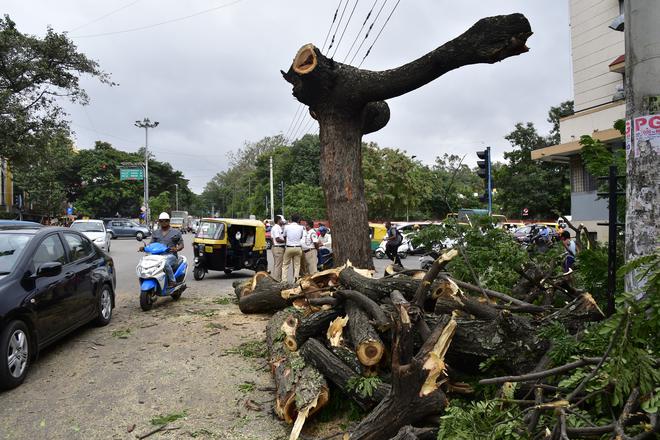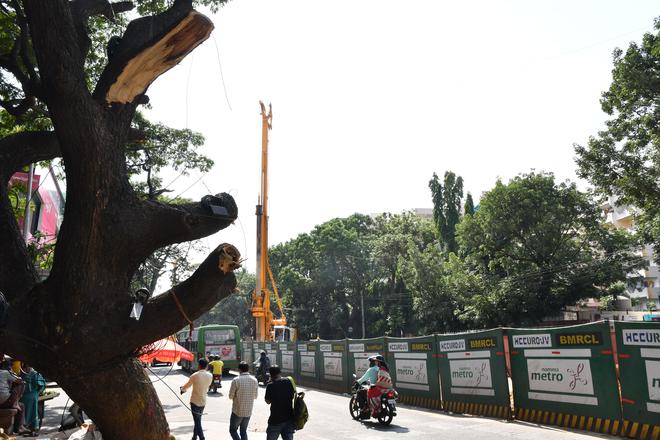Axed, felled, and carted away for umpteen road projects, trees in their thousands have vanished from the once green face of Bengaluru city. But ask the authorities to put a precise number on the trees lost, and a deafening silence greets you. For, a tree census, mandated and reiterated by the Karnataka High Court, is yet to get its first count even after four years. Is it apathy or a deliberate ploy to bulldoze through environmental concerns?
The mandatory tree count has not moved beyond December 2022, piloted by the Bruhat Bengaluru Mahanagara Palike (BBMP) Forest Cell in Malleswaram. But that project showed just why a tech-enabled tree census can be a game-changer in protecting the city’s existing trees. A QR code, affixed to each tree, could be scanned to access the tree’s health status, age, girth, name and other key data.
In 2019, the BBMP inked a Memorandum of Understanding (MoU) with the Institute of Wood Science and Technology to activate the survey the same year. But this was cancelled later, and the tree census has remained on paper.
For Metro alone
Meanwhile, over 3,600 trees were axed for the Metro project alone between 2021 and 2023, although the BBMP has not furnished a clear picture of the lost greenery. Flyovers, underpasses, and other road projects have claimed hundreds of fully grown trees with thick canopies in recent years. The Metro Phase III and other road infrastructure projects are bound to further slice away the city’s green heritage.
Ordering the tree census in 2019, the High Court had stated the BBMP Commissioner would be hauled up for contempt if the count was not executed quickly, recalls environmentalist and petitioner Dattatreya Devare. “Some work did start after the deal with the Wood Institute, but then the BBMP came up with the excuse of Covid and unavailability of people,” he notes.
The BBMP was to survey the trees on roads with help from the Wood Institute. The Deputy Conservator of Forests, Bengaluru Urban was to take the count of trees in private and other properties. “Finally, the census did not move at all. As per the Act, it was the responsibility of the Bengaluru Urban Tree Authority, which they have conveniently delegated to the BBMP. Now neither is doing anything. There is absolutely no seriousness.”

Undetected: Illegal felling
In the absence of verifiable data on trees, as Devare says, it is impossible to detect illegal tree-felling. He explains, “Anyone who fells a tree illegally does it overnight. The road gets concretised immediately, and thereafter only those who had seen the tree before will know if it even existed.”
A few years back, Devare recalls, a localised tree count in the city had identified a particular number of trees in that area. But a civic agency that sought permission to cut trees for a project submitted a number that was less than the census data. It was clear that many trees had vanished without a trace. Combining mapping tools with photos and videos, Project Vruksha founder Vijay Nishanth conducted a tree census on his own in Pattabhirama Nagar ward in 2019. He displayed the results on the website, offering the agencies concerned to scale up. Nothing moved beyond assurances.
Efforts to get a measure of the city’s greenery and conserve it had begun nine years before the 2019 High Court order. The then High Court judge Justice D. V. Shylendra Kumar had written a letter on January 6, 2011, to the Court’s Registrar, expressing pain at the proposed felling of 1,223 of Bengaluru’s famed avenue trees for road-widening: “This will be nothing short of an ecological and environmental disaster. Many such trees are more than a hundred years old and I am not sure whether future generations will be able to see such trees at all.”
Traffic congestion, he said, was due to a lack of planning and not due to the narrowness of roads. He then referred to rumours of a tree mafia that targets well-grown, matured, and developed trees to corner and sell the timber. Treating this letter Suo Moto as a Public Interest Litigation (PIL), the High Court tagged a pending PIL of the Environment Support Group (ESG).

Re-greening strategy
Recalls Leo Saldanha from ESG: “ESG worked with the Court-appointed Amicus curiae, the Chief Conservator of Forests designated to BBMP, and other civil society organisations to help develop an unprecedented strategy for re-greening Bengaluru through direct public participation in collaboration with Ward Committees and civic and forest agencies. This strategy was comprehensively accepted by the Karnataka High Court in the final order issued on August 7, 2014.”
As part of this strategy, a Greening Committee was tasked with executing the re-greening scheme in BBMP zones, enhancing public involvement in greening through ward committees and involving public and private sector firms in greening. The panel had to identify and protect ‘heritage trees’ and other historical/cultural trees and parks, and develop and implement a ‘Tree Patta’ scheme.
Impact on mental health
In the nine years since the 2014 order, the city has lost a big chunk of its green cover. Beyond environmental factors, says Leo, the loss of trees has had a massive impact on mental health. “We are seeing this distress among the population. Violence is more in cities without trees. Besides, with rising temperatures and fewer trees, the working class people have had no respite from the heat. Lack of tree cover, mental health, social distress, and the resultant social conflict are all outcomes,” he explains.
Removal of trees would mean removing the street vendors, who rely on trees for shade. If you are removing street vendors, you are removing security on the streets for women and children in particular, contends Leo.
An effort to build a ground-up system where citizens could take ownership of trees eventually came to naught. He elaborates, “There was no census or re-greening. It is a very significant and substantial loss. Today, there is no register of trees, but a system of tree officers and tree committee that mandates public hearing for all tree-felling. But that committee has gone out of bounds. One thing led to another, and now nobody knows what is happening. Some arbitrary decisions are made.”

One for seven people
A 2014 study, ‘Trees of Bengaluru’ by the Indian Institute of Science (IISc) Centre for Ecological Studies, based on canopy mapping and field data showed that the city had 14.79 lakh trees for a population of 95 lakh. “For every seven persons, there was one tree. But it should have been seven to eight trees for every person, taking into account the carbon dioxide when we breathe,” recalls Dr. T. V. Ramachandra, who led the study. The city’s population now exceeds 1.30 crore with a much diminished green cover.
Another IISc study proved the clear linkage between tree cover and temperature. “Fourteen years ago, we moved in eight directions from the city centre. We noted that wherever there were lakes, open spaces, and tree gardens, temperatures were two degrees lower. It proved the role of trees in microclimate moderation,” he notes.
In the current context, a tree census is critical to ascertain whether a tree is deceased and requires pruning. “This would minimise tree falls during monsoons and heavy winds. From the people point of view, a census is thus very important for them to pose the right questions to the government and the BBMP. The BBMP’s mismanagement of footpaths has choked trees where root respiration does not happen.”
Species diversity
In the words of Devare, a tree census can also track species-wise distribution of trees. “What we require are native species, but we have been predominantly planting some exotic species that suck up the groundwater. Heritage trees can also be identified through a census, provided Karnataka defines them as, say, 50 years old, like how Maharashtra did.”
Tree counts are critical for another key reason: Survival tracking. “The BBMP claims every year that it has planted lakhs of tree saplings, but there is absolutely no monitoring. Compensatory plantation is another issue. It should happen along the roads because we require a lot of green cover to keep temperatures low, helping walkers and cyclists. That is not happening. The BBMP gives excuses that there is no space and the road department does not create tree pits,” says Devare.
Transplantation has been a mixed bag, he says. “A lot of attention is required. Expertise is still evolving. Plus there is no database available about successful experiments in the country and the costs involved. In my view, transplantation should be taken up only if the survival of the tree at a spot is zero per cent, and it has a 20-30 per cent chance elsewhere.”







